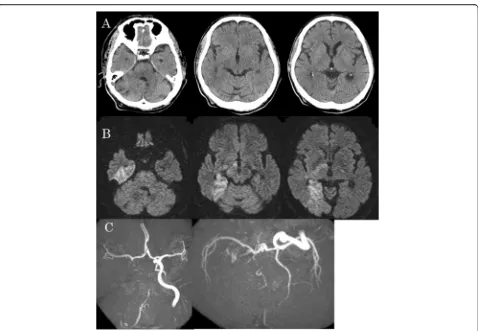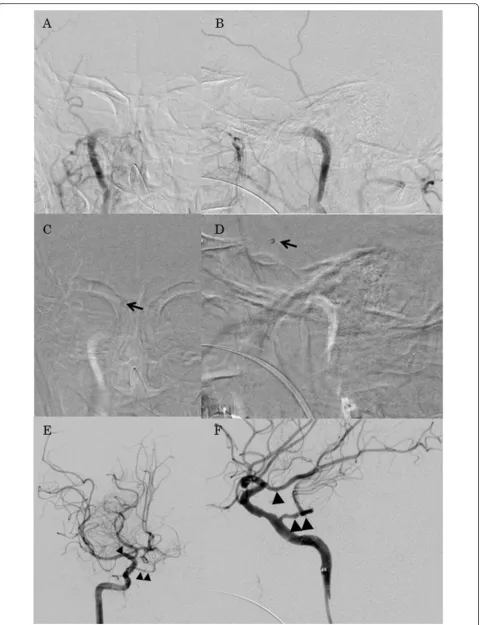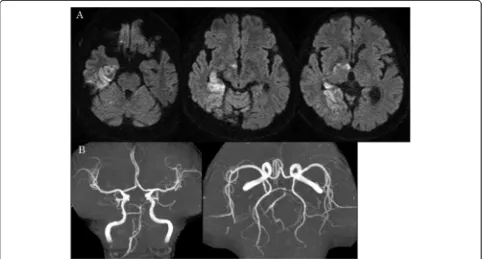C A S E R E P O R T
Open Access
Successful recanalization for internal
carotid artery occlusion with persistent
primitive trigeminal artery manifesting only
as ischemia of the posterior circulation
Ryo Hiramatsu
*, Hiroyuki Ohnishi, Shinji Kawabata, Shigeru Miyachi and Toshihiko Kuroiwa
Abstract
Background:Internal carotid artery (ICA) occlusion mainly manifests as ischemia of the anterior circulation. There are very few reports of ICA occlusion manifesting as only ischemia of the posterior circulation related to a fetal type posterior communicating artery or other arteries.
Case presentation:The authors experienced a case of ICA occlusion with persistent primitive trigeminal artery (PPTA) manifesting only as ischemia of the posterior circulation. In this case, the initial NIHSS score was high (35/42 points). Additionally, cross flow of the anterior communicating artery, ICA occlusion and basilar artery (BA) occlusion were represented on the initial head MRA. Therefore, our first impression was a presumptive diagnosis of BA occlusion. Prior head MRI/MRA performed for screening purposes, had incidentally demonstrated a right PPTA. Based on this understanding, we were able to determine the exact angioarchitectural mechanism of the ICA occlusion. Because of the presence of the PPTA, successful recanalization was accomplished expeditiously. Conclusion:Although the presence of PPTA is rare and ICA occlusion patients with PPTA is even more unusual, if ICA occlusion and BA occlusion appear simultaneously on MRA, the presence of PPTA should be considered.
Keywords:Persistent primitive trigeminal artery, Internal carotid artery occlusion, Basilar artery occlusion, The ischemia of the posterior circulation, Penumbra system
Background
Acute internal carotid artery (ICA) occlusions are often associated with poor outcomes and severe neurologic deficits [1, 2]. Acute ICA occlusions are more resistant than MCA occlusions to administration of intravenous recombinant tissue-type plasminogen activator (rt-PA) [3, 4]. In the Trial of Org 10172 in Acute Stroke Treat-ment, 10 % of patients were diagnosed with ICA occlu-sion, which resulted in neurologic disability in 40 % and mortality in 20 % of patients [5]. ICA occlusion mainly manifests as ischemia of the anterior circulation. There are very few reports of ICA occlusion manifesting only as ischemia of the posterior circulation related to the fetal type posterior communicating artery or any other
arteries [6]. We experienced a case of ICA occlusion with persistent primitive trigeminal artery (PPTA) mani-festing only as ischemia of the posterior circulation.
PPTA is the most common anomaly of carotid-vertebrobasilar anastomoses occurring during embryo-logical development of the intracranial vasculature. The incidence of PPTA has been reported to be between 0.1 and 0.6 % on the basis of conventional angiography and MRA findings [7–9]. Although 25 % of PPTA are associ-ated with intracranial vascular anomalies such as aneu-rysms (13.8 %) [10] and arteriovenous malformations (4.5 %) [11], little is known about the significance of a PPTA in occlusive cerebrovascular disease.
Case presentation
A 65-year-old Japanese man with a history of atrial fib-rillation (treated with oral warfarin) and hypertrophic
* Correspondence:neu106@poh.osaka-med.ac.jp
Department of Neurosurgery, Osaka Medical College, 2-7 Daigaku-machi, Takatsuki City, Osaka 569-8686, Japan
cardiomyopathy suffered sudden onset of stertorous breathing, followed by deteriorated into coma in Decem-ber of 2014. The patient was transported to our hospital by ambulance, and on admission he was experiencing ataxic breathing. Initial National Institute of Health Stroke Scale (NIHSS) was 35/42 points with a Glasgow Coma Scale of 7 (E:1, V:2, M:4). Laboratory examination
revealed a prothrombin time-international normalized ratio (PT-INR) of 1.87. There was no evidence of early ischemic signs on head CT (Fig. 1a). However a high in-tensity area (HIA) was visible in the right medial tem-poral lobe, right hypothalamus, right internal capsule and right medial occipital lobe on head MRI diffusion-weighted imaging (DWI) (Fig. 1b). Head MRA showed
Fig. 1Preoperative head CT and head MRI/MRA.aInitial head CT showed no early ischemic signs.bThe onset head MRI DWI showed HIA in the right medial temporal lobe, right hypothalamus, right internal capsule and right medial occipital lobe.cInitial head MRA showed right ICA occlusion and BA occlusion. However, right anterior and middle cerebral artery were represented clearly by virtue of the Acom
right ICA occlusion and basilar artery (BA) occlusion (Fig. 1c). However, right anterior and middle cerebral ar-teries were patent by virtue of flow via the anterior com-munication artery (Acom) (Fig. 1c). Prior head MRI/ MRA performed for screening purposes, had incidentally demonstrated a right PPTA (Fig. 2). This PPTA joined the middle BA proximal to the superior cerebellar artery (SCA) and fed branched SCAs. Because the initial NIHSS score was high (35 points) and there was clear cross flow from the Acom, BA occlusion was suspected. However, PPTA was not visible in the initial MRA. Therefore, ICA occlusion with PPTA involvement postu-lated. Because PT-INR was 1.87, rt-PA intravenous ther-apy was not utilized and instead endovascular therther-apy was performed.
We inserted a 9Fr long sheath in the right femoral ar-tery. 9Fr Optimo 90 STR (Tokai Medical Products) was placed in the right internal carotid artery at the C1 level. Digital subtraction angiography revealed right ICA
occlusion (Fig. 3a). A coaxial system which consisted of 5MAX ACE Reperfusion Catheter (Penumbra, Inc.), 3MAX ACE Reperfusion Catheter (Penumbra, Inc.) and CHIKAI 14 (ASAHI INTECC CO.) was inserted in the Optimo. The 5MAX ACE was guided to the thrombus proximal to the right PPTA and was connected at this point to the Aspiration Pump (Penumbra, Inc.). We guided the 5MAX ACE distally to the right posterior communication artery (Pcom) and all blood clots were aspirated. After a first pass of the direct aspiration using the 5MAX ACE, we achieved successful recanalization with a Thrombolysis in Cerebral Infarction score (TICI) of 3 (Fig. 3b). Postoperatively there were no new acute ischemic lesions on postoperative MRI DWI (Fig. 4a), and all cerebral vessels including PPTA were visible on postoperative MRA (Fig. 4b). The patient was discharged on postoperative day 13, with a normal neurological examination except for the presence of an upper left quadrantanopia.
(See figure on previous page.)
Fig. 3Operative photographs. aRight ICAO was shown on an anterior-posterior view of the preoperative angiography.bRight ICAO was shown on a lateral view of the preoperative angiography.c The 5MAX ACE Reperfusion Catheter (single black arrow) was guided to the thrombus proximal to the PPTA on an anterior-posterior view of the intraoperative angiography.dThe 5MAX ACE Reperfusion Catheter (single black arrow) was guided to the thrombus proximal to the PPTA on a lateral view of the intraoperative angiography.eSuccessful recanalization achieved a TICI 3 score as shown on an anterior-posterior view of the postoperative angiography. Photographically, Pcom of a fetal type (single black arrow head) and PPTA (double black arrow heads) were shown.fSuccessful recanalization achieved a TICI 3 score as shown on a lateral view of the postoperative angiography. Photographically, Pcom of a fetal type (single black arrow head) and PPTA (double black arrow heads) were shown
Discussion
The PPTA is one of the four well known primitive anasto-moses between the internal carotid artery and the verteb-robasilar system (the hypoglossal, otic, and proatlantal intersegmental arteries comprise the remaining three). It accounts for approximately 80–85 % of persistent anasto-moses [12]. The PPTA originates from the cavernous seg-ment of the ICA and communicates with the BA [13]. Saltzman et al. [14] classified the angiographic appearance of PPTA by conventional angiography into three types ac-cording to the angioarchitectural relationship with the neighboring vessels. Cases may be encountered that do not meet Saltzman et al.’s classification, making it difficult to understand the various types of PPTA. Recently, Weon et al. [15] proposed a new classification scheme for PPTA based on MRA, identifying five different types based on their anatomical relationship with the neighboring arter-ies. According to Weon et al. classification, the PPTA in our case was type 2 [15].
PPTA is frequently associated with other anatomical variations such as absence of the ipsilateral Pcom, verte-bral artery, or BA [16, 17]. In a large case series, approxi-mately 75 % of cases demonstrated different grades of BA hypoplasia [9]. In these circumstances, the BA received its flow almost exclusively from the ICA with supply to the upper brain stem, cerebellum and ipsilateral cerebral hemisphere arising from the ICA [16]. However patients with PPTA who developed ICA occlusion with cross flow from the Acom, are at high risk of severe cerebral infarc-tion and associated BA top syndrome.
In our case, the initial NIHSS score was high (35 points) and Acom cross flow was represented on the ini-tial head MRA. Therefore, our first impression was a presumptive diagnosis of BA occlusion. However, refer-ence to prior head MRA, provided additional informa-tion necessary for a diagnosis of ICA occlusion, not BA occlusion. Additionally, HIA on the initial MRI DWI showed a lesion limited to the posterior cerebral artery (PCA) area. The PPTA in our case was Weon et al.’s classification type 2 (Fig. 2), which is defined as PCA blood supply predominantly from a patent PCom [15]. Based on this understanding, we were able to determine not only the exact angioarchitectural mechanism of the ICA occlusion but also the location of the thrombus (probably, it located at the origin of PPTA continuing to the origin of Pcom). Ultimately, we were able to attain a good result (a modified Ranking Scale of 1 at discharge). Another factor contributing to the good result might be the use of the Penumbra System, not a stent retriever. In this case, because sufficient cross flow from the Acom was observed on the initial head MRA, the thrombec-tomy might lead to incidental embolization in new terri-tories (ENT) or embolization of distal territerri-tories (EDT) with accompanying Acom occlusion. Mokin et al.
reported that an use of direct aspiration (using a 5MAX ACE Reperfusion Catheter) showed less ENT and EDT than the stent retriever in in vitro model experiments [18]. On the other hand, Mulder et al. reported the thrombectomy in posterior circulation stroke through persistent primitive trigeminal artery using a stent re-triever as a case report [19]. Therefore, even though it is still controversial which devices (Penumbra System or stent retriever) can show less ENT and EDT, the Penum-bra System was critically useful in our case.
Conclusions
Although the presence of PPTA is rare and ICA occlu-sion in patients with PPTA is even more unusual, if ICA occlusion and BA occlusion appear simultaneously on MRA or other imaging, the presence of PPTA should be considered.
Consent
Written informed consent was obtained from the patient for publication of this Case report and any accompany-ing images. A copy of the written consent is available for review by the Editor of this journal.
Abbreviations
Acom:anterior communicating artery; BA: basilar artery; DWI: diffusion-weighted imaging; EDT: embolization of distal territories; ENT: embolization in new territories; HIA: high intensity area; ICA: internal carotid artery; NIHSS: National Institute of Health Stroke Scale; PCA: posterior cerebral artery; Pcom: posterior communicating artery; PPTA: persistent primitive trigeminal artery; PT-INR: prothrombin time-international normalized ratio; SCA: superior cerebellar artery; TICI: thrombolysis in cerebral infarction.
Competing interests
The authors declare that they have no competing interest.
Authors’contributions
Study concept and design: RH, SM. Acquisition of data: RH. Analysis and interpretation of data: RH. Drafting of the manuscript: RH, SM. Critical revision of the manuscript for important intellectual content: All authors. All authors read and approved the final manuscript.
Acknowledgements
We thank Dr. Adam Tucker for your help in checking my text as a native speaker acquainted with Neurosurgery.
Received: 25 September 2015 Accepted: 10 March 2016
References
1. Seet RC, Wijdicks EF, Rabinstein AA. Stroke from acute cervical internal carotid artery occlusion: treatment results and predictors of outcome. Arch Neurol. 2012;69:1615–20.
2. Paciaroni M, Balucani C, Agnelli G, Caso V, Silvestrelli G, Grotta JC, Demchuk AM, Sohn SI, Orlandi G, Leys D, et al. Systemic thrombolysis in patients with acute ischemic stroke and Internal Carotid ARtery Occlusion: the ICARO study. Stroke. 2012;43:125–30.
3. Jansen O, von Kummer R, Forsting M, Hacke W, Sartor K. Thrombolytic therapy in acute occlusion of the intracranial internal carotid artery bifurcation. AJNR Am J Neuroradiol. 1995;16:1977–86.
5. Adams Jr HP. Trials of trials in acute ischemic stroke. The Humana Lecture. Stroke. 1993;24:1410–5.
6. Dababneh H, Shikhman A, Moussavi M, Guerrero WR, Panezai S, Kirmani JF. Teaching NeuroImages: comatose patient with bilateral thalamic infarct due to internal carotid artery occlusion. Neurology. 2013;80:e185–186. 7. Eadie MJ, Jamieson KG, Lennon EA. Persisting carotid-basilar anastomosis.
J Neurol Sci. 1964;1:501–11.
8. Fields WS. The significance of persistent trigeminal artery. Carotid-Basilar anastomosis. Radiology. 1968;91:1095–101.
9. O’Uchi E, O’Uchi T. Persistent primitive trigeminal arteries (PTA) and its variant (PTAV): analysis of 103 cases detected in 16,415 cases of MRA over 3 years. Neuroradiology. 2010;52:1111–9.
10. Agnoli AL. Vascular anomalies and subarachnoid haemorrhage associated with persisting embryonic vessels. Acta Neurochir (Wien). 1982;60:183–99. 11. George AE, Lin JP, Morantz RA. Intracranial aneurysm on a persistent
primitive trigeminal artery. Case report. J Neurosurg. 1971;35:601–4. 12. Zhang CW, Xie XD, Yang ZG, Wang CH, You C, Mao BY, He M, Sun H. Giant
cavernous aneurysm associated with a persistent trigeminal artery and persistent otic artery. Korean J Radiol. 2009;10:519–22.
13. Bai M, Guo Q, Sun Y. Rare saccular aneurysm in a medial type persistent trigeminal artery trunk and literature review. Surg Radiol Anat. 2014;36:299–302.
14. Saltzman GF. Patent primitive trigeminal artery studied by cerebral angiography. Acta Radiol. 1959;51:329–36.
15. Weon YC, Choi SH, Hwang JC, Shin SH, Kwon WJ, Kang BS. Classification of persistent primitive trigeminal artery (PPTA): a reconsideration based on MRA. Acta Radiol. 2011;52:1043–51.
16. Eluvathingal Muttikkal TJ, Varghese SP, Chavan VN. Persistent trigeminal artery and associated vascular variations. Australas Radiol. 2007;51 Spec No:B31–33.
17. Goyal M. The tau sign. Radiology. 2001;220:618–9.
18. Mokin M, Setlur Nagesh SV, Ionita CN, Levy EI, Siddiqui AH. Comparison of modern stroke thrombectomy approaches using an in vitro cerebrovascular occlusion model. AJNR Am J Neuroradiol. 2015;36:547–51.
19. Mulder M, Lycklama ANGJ, Dinkelaar W, de Rooij T, van Es A, van der Kallen BF, Emmer BJ. Thrombectomy in posterior circulation stroke through persistent primitive trigeminal artery: a case report. Interv Neuroradiol. 2015;21: 715–8.
• We accept pre-submission inquiries
• Our selector tool helps you to find the most relevant journal
• We provide round the clock customer support
• Convenient online submission
• Thorough peer review
• Inclusion in PubMed and all major indexing services
• Maximum visibility for your research
Submit your manuscript at www.biomedcentral.com/submit


